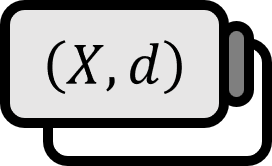Properties of Continuous Functions in Metric Spaces
Theorem: Real Functions
Let two functions $f$, $g$ be functions from a metric space $X$ to the complex numbers.
$$ f:X \to \mathbb{C},\quad g:X \to \mathbb{C} $$
If the two functions are continuous, then $f+g$, $fg$, $f/g$ are also continuous. However, in the last case, it only holds for $g(x)\ne 0$ being $x\in X$.
Proof
Let $(X,d)$ be a metric space, $E\subset X$ a subset, and $p$ an accumulation point of $E$. Suppose two complex-valued functions defined on $E$, $f:E\to \mathbb{C}$, $g: E\to \mathbb{C}$, are given. And suppose the two functions have the following limits at $p$.
$$ \lim \limits_{x \to p}f(x)=A \quad \text{and} \quad \lim \limits_{x \to p}g(x)=B $$
Then
$\lim \limits_{x \to p}(f+g)(x)=A+B$
$\lim \limits_{x \to p}(fg)(x)=AB$
$\lim \limits_{x \to p}\left( \frac{f}{g} \right)(x)=\frac{A}{B},\ B\ne 0$
For two $(X,d_{X})$, $(Y,d_{Y})$, let $E\subset X$ and assume $p \in E$, $f : E \to Y$. Then the following two conditions are equivalent.
$f$ is continuous at $p$.
$\lim \limits_{x \to p} f(x)=f(p)$ is true.
It holds by Lemma 1 and Lemma 2.
■
Theorem: Vector Functions
Let $f_{1}$, $f_{2}$, $\cdots$, $f_{k}$ be functions from a metric space $X$ to the real numbers. And let $\mathbf{f}$ be defined as follows.
$$ \mathbf{f}: X \to \mathbb{R}^{k} \quad \text{and} \quad \mathbf{f}(x)=(f_{1}(x),\cdots,f_{k}(x)) $$
Then
(a) A necessary and sufficient condition for $\mathbf{f}$ to be continuous is that each of the $f_{1},\cdots,f_{k}$ is continuous.
(b) Suppose $\mathbf{g}$ is a function defined in the same way as $\mathbf{f}$. If $\mathbf{f}$, $\mathbf{g}$ are continuous, then $\mathbf{f}+\mathbf{g}$, $\mathbf{f}\cdot \mathbf{g}$ are also continuous.
Proof
(a)
Assuming each of $f_{i}$ is continuous, by the definition of continuity, for each of $f_{i}, \varepsilon_{i}$ there exists
$$ d_{X}(x,p)<\delta_{i} \implies \left| f_{i}(x)-f_{i}(p) \right|< \varepsilon_{i} \quad(i=1,\cdots,k) $$
such that
$$ d_{X}(x,p)<\delta \implies \left| \mathbf{f}(x)-\mathbf{f}(p) \right|=\sqrt{\sum\limits_{i=1}^{k}\left|f_{i}(x) -f_{i}(p) \right|^{2}}<\sum \limits _{i=1} ^{k}\varepsilon_{i}=\varepsilon $$
Therefore, $\mathbf{f}$ is continuous. Conversely, if we assume $\mathbf{f}$ is continuous, then for some $\varepsilon>0$
$$ d_{X}(x,p)<\delta \implies \left|f_{i}(x)-f_{i}(p) \right|\le \left|\mathbf{f}(x)-\mathbf{f}(p) \right|<\varepsilon $$
Thus, each of $f_{i}$ is continuous.
■
(b)
It holds by Theorem 1 and (a).
■
